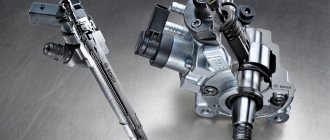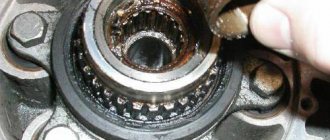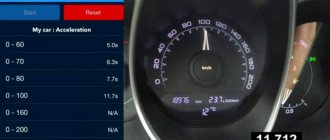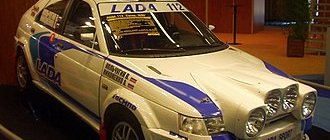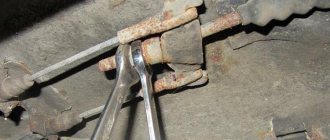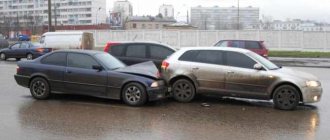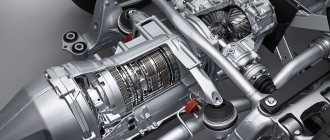We are on Twitter:
Login Registration
Automotive news
The Ministry of Health has approved a new procedure for the medical examination of drivers. A diagnostic card for compulsory motor liability insurance is no longer needed. The Central Bank has updated the methodology for establishing damage under compulsory motor liability insurance. Rules for the movement of heavy trucks in the automatic weight control zone have been adopted. The Federal Tax Service has approved a form for reporting the death or destruction of a vehicle. In Russia, it is forbidden to disembark children without a ticket from buses. In the traffic rules a new sign 6.22 has been introduced - “photo and video recording” Tests for alcohol dependence have been postponed for another year The Ministry of Health has updated the requirements for the complete set of car first aid kits The Ministry of Transport has approved the procedure and terms of storage of diagnostic maintenance cards
/ Legal articles on the topic of automobile law / Automotive technical expertise / How to determine the speed of a car based on the braking distance
How to determine the speed of a car based on the braking distance
One of the main factors influencing the investigation of the circumstances of an accident is determining the distance that the car traveled before braking. Knowing the braking distance, you can calculate the ground speed an instant before the collision.
What does braking distance depend on?
The indicator under consideration is not a constant value and can vary for a number of reasons. All factors influencing the braking distance can be divided into two large groups: driver-dependent and driver-independent. Reasons beyond the control of the person driving include:
It is easy to guess that in rain, snow or ice, the distance required to stop a car will be greater than on dry asphalt. Braking will also take a long time when driving on smooth asphalt, to which stone chips have not been added. Here the wheels have nothing to catch on, unlike rough surfaces.
Note: it is worth noting that poor quality of the road (potholes, potholes) does not lead to an increase in the distance required to stop. The human factor plays a role here. Trying to save the suspension, drivers rarely reach high speeds on such roads. Accordingly, the braking distance here is minimal.
Factors depending on the driver or owner of the car:
- brake condition;
- system design;
- presence of ABS;
- type of tires;
- vehicle load;
- movement speed.
Determining the speed of the car based on the obtained deformations
Only a very small number of experts determine the speed of a car in this way. Although the dependence of car damage on its speed is obvious, there is no single effective, accurate and reproducible method for determining speed from the resulting deformations. This is due to the huge number of factors influencing the formation of damage, as well as the fact that some factors simply cannot be taken into account. The formation of deformations can be influenced by:
Determination of speed at the moment of impact (collision)
The speed at the time of a collision is usually determined by the braking mark, but if this is not possible for a number of reasons, then approximate speed figures can be obtained by analyzing the injuries sustained by a pedestrian and the damage caused by a collision with a vehicle.
For example, the speed of a car can be judged by the characteristics of a bumper fracture - a trauma specific to being hit by a car, which is characterized by the presence of a transverse fragmentation fracture with a large fragment of bone of an irregular diamond shape on the side of the impact. Localization when hit by a bumper of a car is the upper or middle third of the lower leg, for a truck - in the thigh area.
When and how measurements are taken
Braking distance calculations may be required in the following cases:
- technical testing of the vehicle;
- checking the capabilities of the car after modifying the brakes;
- forensic examination.
As a rule, the formula S=Ke*V*V/(254*Fs) is used in the calculation. Here S is the braking distance; Ke – braking coefficient; V₀ — speed at the start of braking; Фс – coefficient of adhesion to the coating.
The coefficient of road adhesion varies depending on the condition of the surface and is determined according to the following table:
| Road condition | Fs |
| Dry | 0.7 |
| Wet | 0.4 |
| Snow | 0.2 |
| Ice | 0.1 |
The Ke coefficient is a static value and is unity for all the most common passenger vehicles.
Example: how to calculate the braking distance of a car when the speedometer shows 60 km/h in the rain? Given: speed 60 km/h, braking coefficient – 1, adhesion coefficient – 0.4. We count: 1*60*60/(254*0.4). As a result, we get the figure 35.4, which is the braking distance in meters.
The table shows how many meters the car will continue to move until it comes to a complete stop. It should be taken into account that no other indicators are taken into account (turns, potholes on the road, oncoming traffic, etc.). It is doubtful that in real conditions on an icy road, a car will be able to slide for a kilometer without encountering a pole or bump stop.
| Speed | Dry | Rain | Snow | Ice |
| km/h | meters | |||
| 60 | 20,2 | 35,4 | 70,8 | 141,7 |
| 70 | 27,5 | 48,2 | 96,4 | 192,9 |
| 80 | 35,9 | 62,9 | 125,9 | 251,9 |
| 90 | 45,5 | 79,7 | 159,4 | 318,8 |
| 100 | 56,2 | 98,4 | 196,8 | 393,7 |
| 110 | 68 | 119 | 238,1 | 476,3 |
| 120 | 80,9 | 141,7 | 283,4 | 566,9 |
| 130 | 95 | 166,3 | 332,6 | 665,3 |
| 140 | 110,2 | 192,9 | 385,8 | 771,6 |
| 150 | 126,5 | 221,4 | 442,9 | 885,8 |
| 160 | 143,9 | 251,9 | 503,9 | 1007,8 |
| 170 | 162,5 | 284,4 | 568,8 | 1137,7 |
| 180 | 182,2 | 318,8 | 637,7 | 1275,5 |
| 190 | 203 | 355,3 | 710,6 | 1421,2 |
| 200 | 224,9 | 393,7 | 787,4 | 1574,8 |
The main factor influencing the accuracy of the calculation
The only variable in the speed formula is the braking distance. Manual calculation of this value under ideal conditions (driving at a speed of 60 km/h on a dry asphalt road, braking without skidding) can be done using the formula
v – vehicle speed at the beginning of braking, m/s;
μ – friction coefficient;
g – free fall acceleration, m/s2.
Another formula to check the correctness of the initial calculation
Ke – the value of the braking coefficient;
V – speed at the moment of braking;
Фс – the value of the coefficient of adhesion of tires to the road surface (in dry weather - 0.7, in rainy weather - 0.4; in snow - 0.2; in ice - 0.1).
So, when driving on a dry asphalt road at a speed of 60 km/h, the braking distance will be S = 1*60*60/(254*0.7) = 20.25 m. When driving on an icy road, on which Fs drops from 0.7 to 0.1, the value of S will increase 7 times (141.7 m).
Thus, the main task for correctly calculating speed is determining the stopping distance. Its composition, in addition to the braking distance itself, includes footage pertaining to:
How to increase the intensity of deceleration
From the above, it became clear what is called the braking distance and what this indicator depends on. However, is it possible to reduce the distance required to stop a car? Maybe! There are two ways to do this - behavioral and technical. Ideally, the driver combines both methods.
- Behavioral method - you can reduce the braking distance if you choose a low speed on slippery and wet roads, take into account the degree of load of the car, and correctly calculate the braking capabilities of the car depending on its condition and model year. Thus, a Moskvich developed in 1985 will not be able to brake as effectively as a modern Hyundai Solaris, not to mention more respectable and technologically advanced models.
- Technical method - a method of enhancing braking capabilities, based on increasing the power of the braking system and the use of auxiliary mechanisms. Manufacturers of modern vehicles actively use such methods of improving brakes, equipping their products with anti-lock braking systems, braking assistance systems, using more efficient brake discs and pads.
It should be remembered that reducing the time required to stop is one of the ways to ensure a safe trip. Therefore, every driver must constantly monitor the technical condition of his “iron horse”, promptly maintain and repair the braking system. In addition, it is important to choose the driving speed taking into account the surrounding situation: time of day, road condition, car model, etc.
What is needed to calculate braking distance
To calculate the braking distance, the formula of which is indicated in the figure with explanations, it is not enough to know instantaneous dry data.
Theoretically, to evaluate the braking performance of a car, it is necessary to use a lot of data:
There are a number of points to consider here. For example, the effectiveness of the braking system in each car can be different and this goes without saying. The hydraulic brake system gives a delay of at least 0.2-03 s, and the pneumatic brakes installed on most trucks and buses are even longer, up to 0.6 s. In addition, there is such a thing as an increase in braking force from zero to a maximum value, and this also takes from 0.4 to 0.6 s, while the influence of speed on the braking distance in this case increases squared, that is, with increasing speed is doubled, the braking distance will be four times longer.
Formulas for calculating stopping and braking distances, as well as safe distances.
In the theory exam there is a question about the average reaction time of a driver, the correct answer to which is 1 second. The traffic police tickets also contain a question related to safe distance. There are questions regarding braking. But, as they say, a theory is a theory, which, alas, as a rule, has nothing in common with practice.
Firstly, what you taught in the tickets is a theory based on averages and various studies. In fact, the driver's reaction time, stopping and braking distance depend on many factors and cannot be accurately calculated for all cases. Nevertheless, every driver should be able to calculate these parameters at least approximately.
Empirical formula for calculating braking distance
Having an excellent driver's eye and sufficient experience, everyone will be able to determine the distance to an object by eye, at least approximately. Driving experience shows that to instantly calculate the braking distance by speed, you just need to glance at the speedometer, estimate the distance to the obstacle, then the braking distance will be equal to half the number that the speedometer shows. That is, based on the empirical formula for calculating the braking distance, the safe distance to any object will be equal to the instantaneous speed, divided in half. In almost the same way, they calculate the speed of a car along the braking distance.
In this case, it is necessary to take into account such a concept as stopping distance, this is the term of traffic police experts and it takes into account not only the braking distance itself, but also the reaction speed, as well as the reaction time of the brake system. In principle, this is the distance to the absolute stop of the car from the moment when the driver detected the obstacle. Naturally, the stopping distance is always longer than the braking distance, since the average reaction speed of a healthy and sober driver is about 0.8 s, and the braking system is activated in another 0.2-0.3 s. Therefore, another 1.1 s will pass before the car comes to a complete stop, and at a speed of 60 km/h the car travels 16.6 meters in one second. Almost seventeen meters, which will inevitably be added to the length of the braking distance and which is rarely taken into account by most drivers. This is precisely why it is necessary to take at least a theoretical calculation of the braking distance seriously.
Car braking distance
Braking distance is the distance that the vehicle will travel between the driver's contact with the brake pedal and the vehicle coming to a complete stop. It is also worth understanding the differences between “normal braking” and “emergency braking”. In particular, we must not forget that weather conditions affect braking distances. If there is snow on the road, the braking distance naturally increases.
Here is the formula for calculating the braking distance:
Calculation example: imagine that you are driving at a speed of 50 km/h in the city and approach a pedestrian crossing along which children are walking. Calculation: (50 km/h : 10) x (50 km/h : 10) = 25 (meters). Thus, the braking distance of your car is 25 meters. Therefore, you must take into account the length of the braking distance in order to calmly start braking in a timely manner and stop before the pedestrian crossing.
How to calculate the speed of a car based on the braking distance
How to determine the speed of a car based on the braking distance
One of the main factors influencing the investigation of the circumstances of an accident is determining the distance that the car traveled before braking. Knowing the braking distance, you can calculate the ground speed an instant before the collision.
Driver reaction time and path
Driver reaction time is the time that will pass from the moment the driver detects a danger on the road until the start of taking measures to prevent it.
The driver's reaction path is the distance the vehicle will travel from the moment the driver detects a hazard on the road until the brake pedal is pressed.
Here is the formula for calculating the distance a car will travel when the driver reacts to danger:
(Speed in km/h: 10) x 3 = reaction distance in meters
Calculation example: imagine that you are driving at a speed of 100 km/h along a country road and suddenly an elk runs out onto the road. Calculation: (100 km/h: 10) x 3 = 30 (meters). That is, after you react to a danger on the road, your car will travel about 30 meters. Add to this the braking distance of the car.
Attention: these rules are not scientifically correct formulas and provide only approximate values!
Formulas for calculating speed along braking distance
After a traffic accident, the actual braking distance of the car is measured by traffic police officers or an investigator by recording the tire tracks on the asphalt and entering the data into a special calculation table. Several factors are taken into account:
First of all, you need to quickly establish the speed at which the car was moving before braking. It is calculated as follows
The acceleration of free fall is a physical constant and does not change, no matter in what formula its value is used. The speed from km/h must be converted to m/s, in the ratio 36 to 10: 36 km/h = 10 m/s. According to GOST 25478-91, the permissible minimum efficiency of the vehicle braking system is 0.64. This means that per ton of vehicle weight there must be a braking force of at least 640 kg.
Car stopping distance
Stopping distance is the distance traveled by a vehicle from the moment the driver detects a danger on the road until the car comes to a complete stop.
If you want to calculate a car's stopping distance, you must add to the car's braking distance the distance covered during the driver's reaction time. Here's how to do it:
The first value in the expression is the driver reaction path traveled by the car while the driver is reacting to a hazard on the road. The second expression is the formula for calculating the braking distance. In order to calculate the stopping distance of the vehicle, it is necessary to add both results together.
Calculation example: you are driving your car at a speed of 50 km/h. Calculation: (50 km/h : 10) x 3 = 15 meters of distance the car will travel when responding to a danger on the road (50 km/h : 10) x (50 km/h : 10) = 25 meters will be the braking distance of the car. As a result, adding both values, we find that the stopping distance of the vehicle will be 40 meters.
Attention: these rules are not scientifically correct formulas and provide only approximate values!
Calculation of speed during examination
To expertly determine the initial speed of a machine, specialists use the formula:
Va = 0.5*tз*j + √2Sь*j,
Where
tз – time during which the vehicle speed slows down, s;
j – deceleration constant at the moment of braking, m/s2 (determined by reference, based on GOST 25478-91);
Sу – length of the trail during braking, m.
On a dry road, j is equal to 6.8 m/s2, so the skidding speed of a car braking at a distance of 21 meters is 64.5 km/h.
After the driver begins to react to the environment, the car goes through the so-called stopping distance until the speed is completely zeroed.
So = (S1 + S2 + S3 + S4) = (t1 + t2 + 0.5*t3)*Va + Va/2j,
Where
t1 – driver reaction;
t2 – delay of the hydraulic drive of the brake system;
tз – increase in deceleration.
The time interval t4 (full stop time) is calculated as the ratio of the skidding speed Vу to the deceleration j. The time until the deceleration rate increases depends on three indicators:
- type of drive;
- road surface condition;
- vehicle weight.
To determine it, half should be subtracted from the initial speed Va until the minimum speed tз*j is established. Thus, the total time of the dynamic part of an accident for a car is t0 = t1 + t2 + t3 + t4 = T + Va/j, s.
Attention! The deceleration increase time for a pneumatic drive is longer than for a hydraulic drive. It increases with the curb weight of the vehicle and the coefficient of adhesion.
Distance
- Three car lengths . Anyone traveling in urban areas must maintain a distance of at least 15 meters, or three car lengths.
- Half speedometer : for a safe distance outside of populated areas, pay attention to the speed of the car. In order to calculate a safe distance, divide by 2 the current speed shown by the speedometer. As a result, you will get the distance to other cars in meters. Example: At a speed of 70 km/h, you must keep at least 35 meters from the vehicle in front. Moreover, this applies to dry asphalt in the summer.
- Double distance : In case of poor visibility or bad road conditions, you should double the safe distance.
Analysis of methods for determining car speed during an accident
Along the brake track
Advantages:
- relative simplicity of the method;
- a large number of scientific papers and compiled methodological recommendations;
- fairly accurate result;
- possibility of quickly obtaining examination results.
Flaws:
- in the absence of tire tracks (if the car, for example, did not brake before the collision, or the characteristics of the road surface do not allow the skid mark to be measured with sufficient reliability), this method is impossible;
- does not take into account the impact of one vehicle during a collision on another, which may.
According to the law of conservation of momentum
Advantages:
- the ability to determine the speed of a vehicle even in the absence of signs of braking;
- with careful consideration of all factors, the method has a high reliability of the result;
- ease of use of the method in cross collisions and collisions with stationary vehicles.
Flaws:
- the lack of data on the vehicle’s driving mode leads to inaccurate results;
- compared to the previous method, more complex and cumbersome calculations;
- the method does not take into account the energy spent on the formation of deformations.
Based on the deformations obtained
Advantages:
- takes into account energy costs for the formation of deformations;
- does not require the presence of brake marks.
Flaws:
- questionable accuracy of the results obtained;
- a huge number of factors taken into account;
- it is often impossible to determine many factors;
- lack of standardized, reproducible determination methods.
In practice, two methods are most often used - determining speed from the braking trace and based on the law of conservation of momentum. When using these two methods simultaneously, the most accurate result is ensured, since the methods complement each other.
Other methods for determining the speed of a vehicle have not received significant widespread use due to the unreliability of the results obtained and/or the need for cumbersome and complex calculations. Also, when assessing the speed of a car, the testimony of witnesses to the incident is taken into account, although in this case one must remember about the subjectivity of the perception of speed by different people.
To some extent, analyzing video from surveillance cameras and DVRs can help to understand the circumstances of the incident and ultimately obtain a more accurate result.
Safe distance between cars
According to clause 13.1 of the Traffic Rules, the driver must keep a sufficient distance from the vehicle in front that will allow him to brake in time.
Failure to maintain distance is one of the main causes of transport accidents.
When a vehicle in front comes to a sudden stop, the driver of a car closely following him does not have time to brake. The result is a collision between two and sometimes more vehicles.
To determine the safe distance between cars while driving, it is recommended to take an integer speed value. For example, the speed of a car is 60 km/h. This means that the distance between him and the vehicle in front should be 60 meters.
Braking a car at speed. What is the braking distance at speeds of 50, 80 and 110 km/h.
Most automakers like to brag about their products, thus advertising various technical characteristics of their cars, focusing mainly on the dynamics of acceleration from 0 to 100 km/h. But not a single car company talks about how quickly any of their cars stop in place.
In our opinion, such data is extremely necessary for drivers to remind them that an object moving on the road cannot be stopped instantly. Naturally, each car, due to the characteristics of the braking system, has its own individual braking distance. But still, there is a specific table of average values showing what kind of braking distance virtually any car has at a certain speed. For our part, we advise every driver to learn it by heart.
It is natural and understandable to everyone, and this must be remembered, the higher the speed of your car, the longer the braking distance will be during sudden emergency braking. It is also necessary to take into account weather conditions, as well as the road surface and the very condition of the car tires. By memorizing the braking distance parameters at different speeds like a multiplication table, you will be able to better control your car while driving, maintain the correct distance and, if necessary, be able to brake in time and urgently, thereby avoiding an accident.
This is especially important for novice drivers who have only recently received their license and got behind the wheel of a car.
Braking conditions
The effectiveness of a sudden stop depends on various accompanying conditions. It is important to take into account the driver’s reaction, the condition of the car’s braking system and road surface, as well as weather conditions.
To correctly calculate the braking distance (S), you need to use the following data:
For this, the following formula is used:
Road grip is directly affected by the condition of the road surface. On a dry road the car will stop in 20.25 meters, on a wet road the braking distance will be 35.4 meters, and on ice it will take 70.8 meters to stop completely. Accordingly, the coefficient of adhesion under different conditions will differ.
The efficiency of driving and stopping a car is directly affected by the method of braking. For example, suddenly pressing the brake pedal can jam the wheels and cause the vehicle to skid. To prevent such situations, modern car manufacturers use the ABS system.
How to calculate the total stopping time and the final stopping distance?
It is impossible to carry out accurate calculations on an abstract car. Often the braking distance is calculated based on what this value was for a particular car at a certain speed. As we have already said, the increase in braking distance is quadratic to the increase in vehicle speed.
But there are also statistical averages. It is accepted that an average-sized passenger car at a speed of 10 km/h has a braking distance of 0.4 m. If we take this ratio as a basis, then we can calculate the braking distance for vehicles moving at a speed of 20 km/h (the value is 1.6 m) or 50 km/h (the value is 10 meters) and so on.
To more accurately calculate the braking distance, you need to use additional information. For example, if we take into account the degree of tire resistance (the friction coefficient for dry asphalt is 0.8, and for an icy road - 0.1). This parameter is substituted into the following formula. Braking distance = square of the speed (in kilometers/hour) divided by the friction coefficient multiplied by 250. If the car is moving at a speed of 50 km/h, then according to this formula the braking distance is already 12.5 meters.
To obtain a specific figure for the driver's reaction path, there is another formula. The calculations are as follows. Reaction path = car speed divided by 10, then multiplied by 3. If we substitute the same car moving at a speed of 50 km/h into this formula, then the reaction path will be 15 meters.
The car will come to a complete stop (the same speed of 50 kilometers per hour) in 12.5+15=27.5 meters. But these are not the most accurate calculations.
Thus, the time of complete stop of the vehicle is calculated by the formula:
P (full stop) = (multiplier of the braking efficiency coefficient and initial braking speed divided by the multiplier of free fall acceleration and the coefficient of longitudinal adhesion of tires to asphalt) + driver reaction time + response period of the brake system drive + multiplier of the braking force rise time by 0.5.
So, as you can see, the determination of a complete stop of a car is influenced by many factors, which can be completely different depending on the situation on the road. For this reason, once again: the driver must always control what is happening on the road.
What factors influence braking and stopping distance?
We already wrote above that the length of the braking distance is influenced by many factors. We invite you to consider them in more detail.
Speed
This is the key factor. This means not only the speed of the car, but also the reaction speed of the driver. It is believed that everyone has approximately the same reaction, but this is not entirely true. Driving experience, a person’s health status, medication use, etc. play a role. Also, many reckless drivers ignore the law and are distracted by smartphones while driving, which ultimately can lead to catastrophic consequences.
Remember one more important point. If a car's speed doubles, its braking distance quadruples! The 1:1 ratio doesn't work here.
Road conditions
Undoubtedly, the length of the brake line is influenced by the condition of the road surface. On an icy or wet road it can increase significantly. But these are not all the factors. You should also be wary of fallen leaves, on which tires glide perfectly, cracks in the surface, holes, and so on.
Tires
The quality and condition of the rubber greatly influence the length of the brake line. Often, more expensive tires provide better grip on the road surface. Please note that if the tread depth has worn off beyond the permissible value, then the rubber loses its ability to drain a sufficient amount of water when driving on a wet road. As a result, you may encounter such an unpleasant thing as hydroplaning - when the car loses traction and becomes completely uncontrollable.
To shorten the braking distance, it is recommended to maintain optimal tire pressure. Which one exactly - the automaker will answer this question for you. If the value deviates upward or downward, the braking line will increase.
Depending on the coefficient of adhesion of the tires to the road surface, this indicator will vary. Here is a comparative table of the dependence of the braking distance on the quality of the road surface (a passenger car whose tires have an average coefficient of adhesion):
| 60km/h. | 80 km/h. | 90 km/h. | |
| Dry asphalt, m. | 20,2 | 35,9 | 45,5 |
| Wet asphalt, m. | 35,4 | 62,9 | 79,7 |
| Snowy road, m. | 70,8 | 125,9 | 159,4 |
| Ice, m. | 141,7 | 251,9 | 318,8 |
Of course, these indicators are relative, but they clearly illustrate how important it is to monitor the condition of car tires.
Technical condition of the machine
A car can only go on the road in good condition - this is an axiom that does not require proof. To do this, carry out routine diagnostics of your car, make timely repairs and change the brake fluid.
Remember that worn brake rotors can double the brake line.
Distraction on the road
While the vehicle is moving, the driver has no right to be distracted from driving the vehicle and monitoring the traffic situation. Not only its safety, but the lives and health of passengers, as well as other road users, depend on this.
Here's what happens in a driver's brain when an emergency occurs:
- assessment of the road situation;
- making a decision - to brake or maneuver;
- response to the situation.
Depending on the driver's innate abilities, the average reaction speed ranges from 0.8 to 1.0 seconds. This setting concerns an emergency situation, rather than an almost automatic process when slowing down on a familiar stretch of road.
To many, this time period seems insignificant to pay attention to, but ignoring the danger can lead to fatal consequences. Here is a table of the relationship between the driver’s reaction and the distance traveled by the car:
| Vehicle speed, km/h. | Distance until the brake is pressed (the time remains the same - 1 second), m. |
| 60 | 17 |
| 80 | 22 |
| 100 | 28 |
As you can see, even a seemingly insignificant second of delay can lead to dire consequences. That’s why every motorist should never break the rule: “Don’t be distracted and stick to the speed limit!”
Various factors can distract the driver from driving:
- mobile phone - even just to see who is calling (when talking on the phone, the driver’s reaction is identical to the reaction of a person in a state of mild alcohol intoxication);
- watching a passing car nearby or enjoying beautiful scenery;
- fastening the seat belt;
- eating while driving;
- falling of an unsecured DVR or mobile phone;
- clarification of the relationship between driver and passenger.
In fact, it is impossible to make a complete list of all the factors that can distract a driver from driving. In view of this, everyone should be attentive to the road, and passengers will benefit from the habit of not distracting the driver from driving.
State of alcohol or drug intoxication
The laws of most countries around the world prohibit driving under the influence of drugs or alcohol. This is not because drivers are prohibited from enjoying life to the fullest. The braking distance of the car depends on this condition.
When a person is under the influence of drugs or alcohol, his reaction is reduced (this depends on the degree of intoxication, but the reaction will be slow in any case). Even if the car is equipped with the most advanced systems and braking assistants, pressing the brake pedal too late in an emergency situation will lead to an accident. In addition to braking, a drunk driver reacts more slowly to the need to perform a maneuver.


